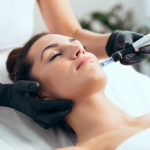
Photo By Alim Yakubov at Shutterstock
Exposure to sunlight increases the risk of skin cancer. This is relatively common knowledge, but skin is exposed to sunlight almost every day. People often forget sunscreen, and the sunny climate in Southlake, TX encourages outdoor activities.
Small growths on the skin are a common occurrence, but they should not be ignored. Consult a dermatologist to make sure growths are not cancerous. Dermatologists may recommend removal of benign growths to prevent skin cancer in the future.
Blue Light Therapy
Photodynamic, or blue-light, therapy is a medical treatment involving a photosensitizing molecule activated by light exposure. Dermatologists use blue light therapy regularly, and it is also used in oncology, cosmetic surgery, oral medicine, and ophthalmology.
Dermatologists in Southlake, TXuse photodynamic therapy, PDT, to remove actinic keratosis and other superficial skin lesions. The procedure reduces the risk of developing skin cancer in the future. PDT is not appropriate for people with light-sensitive medical conditions.
Actinic Keratosis
Actinic keratosis, or solar keratosis, are small, scaly bumps on the skin. Lesions occur on skin that is frequently exposed to sunlight, such as the face, ears, head, forearms, lips, and hands. The bumps range can be as
small as a pinhead or grow to one inch across. Dermatologists remove these lesions because approximately 10% of precancerous keratosis become a type of skin cancer called squamous cell carcinoma.
People that spend a lot of time outdoors have a higher risk of developing actinic keratosis. Certain physical characteristics are associated with increased risk, including fair skin, red or blond hair, and gray, blue, or green eyes. People with dark complexions are also susceptible, especially if they spend time outside without appropriate sunscreen or protective clothing.
Levulan and BLU-U
Levulan Kerastick is a type of topical solution used with a BLU-U Blue Light Photodynamic Therapy (PDT) Illuminator to perform photodynamic therapy. BLU-U does not emit UVA or UVB light. It works best for thin to moderately thick actinic kerosesis on the face and scalp.
The chemical solution applied to skin contains aminolevulinic acid. Photodynamic therapy, PDT, works because aminolevulinic acid reacts to the wavelength of blue light. Actinic keratosis weakens skin at lesion sites.
The weakened skin absorbs the chemical solution. Blue light hits aminolevulinic acid in the skin, and the reaction creates oxygen radicals that destroy cancerous or precancerous cells in the treated area.
PDT Procedure
Tell dermatologists in Southlake, TX if you are taking any oral medications or medication applied to the scalp before treatment begins. Wash the treatment area and gently pat dry. Do not apply lotions or moisturizer before the procedure.
Dermatologists apply a light-sensitizing chemical solution to skin in the target area. The length of time between solution application and blue light exposure is called the incubation period. Patients sit in a darkened room during the incubation period, which is approximately an hour for most procedures. Treated skin is exposed to blue light for approximately 17 minutes.
Some people feel a prickling or burning sensation during treatment, but this usually fades within a minute after light exposure ends. Only 3% of people in PDT treatment studies chose to discontinue treatment due to discomfort.
Solar keratosis usually heal within a week after treatment.
Side Effects and Aftercare
Many people experience sensitivity to sunlight for a short time after skin is exposed to blue light. Bring a hat, umbrella, or other protective clothing or
accessories to the appointment to avoid sun exposure on the way home.
Shield skin from sunlight or limit time outside to avoid exposure to bright lights for 24 to 48 hours. Sunscreen may not be sufficient to protect skin from photosensitivity to visible light during this time.
Do not expose the treated lesions to sunlight or any bright lights for at least 40 hours after the chemical solution was applied. This includes household lights at close range. Sensitivity to light is only temporary and depends on the length of treatment. PDT does not cause permanent or ongoing light sensitivity.
The most common side effects of PDT include skin discoloration, crusts or scaling over the destroyed lesions, and a slight itching, stinging, or burning sensation. Redness, swelling, and scaling may occur in the treated area immediately after treatment. These side effects usually subside within a few days and resolve completely within 4 weeks.
Liquid Nitrogen and Cryosurgery
Cryosurgery is a traditional treatment that was first used over 100 years ago. Dermatologists use liquid nitrogen for cryosurgery to remove skin lesions such as precancerous growths, cancer, skin cancer, dysplastic moles, warts, and some skin cancers such as melanoma. Liquid nitrogen may be used to remove actinic keratosis as well.
Procedure and Side Effects
Cryosurgery works best on skin without thick hair cover. Liquid nitrogen is applied with a cotton-tipped dipstick or with spraying equipment. Both methods are fairly simple and effective for benign, premalignant, and malignant lesions.
Spray methods include timed spot freeze technique, the paintbrush method, and rotary or spiral patterns. Possible side effects, including bleeding, blister formation, headache, hair loss, or loss of skin pigmentation. These effects are usually very mild.
Cryosurgery vs PDT
Dermatologists perform cryosurgery and PDT as outpatient procedures without using injectable anesthesia. Cryosurgery has a very low risk of infection. Risk of infection is so low it is not listed as a possible side effect of PDT.
PDT only involves two steps and the procedure is completed within 24 hours. Patients experience very little downtime. There are no prescriptions to fill, and no need to remember a daily medication. Cryosurgery is often completed in 15 to 25 minutes. PDT requires more of a time investment, but it is still less than a day.
Blue light therapy is very flexible. People choose to have only a few lesions treated or treat several areas at once. The size of the treatment area is the most significant difference between cryosurgery and PDT.
Cryosurgery only treats a very small area with each application. It is usually targeted at only one growth at a time. PDT can be used over large areas. The dermatologists and professional staff at Compassion Dermatology in Southlake, TX advise clients and help them choose the most appropriate procedure.


